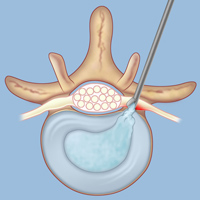Surgical technique for a herniated disc has come a long way recently with the development of minimally invasive techniques. Although traditional open surgery may sometimes be necessary, Och Spine at NewYork-Presbyterian/Weill Cornell Medical Center is a leader in newer, minimally invasive options.

The goal of microdiscectomy is to remove the bulge from the herniated portion of the disc and to relieve pressure on the affected nerve.
Minimally invasive microdiscectomy: This minimally invasive technique reduces the trauma associated with open surgery and allows patients a shorter recovery time, less post-operative pain, and a faster return to normal activities. Minimally invasive spine surgery requires only tiny incisions and often takes less than an hour. The goal of minimally invasive microdiscectomy is to remove the bulge from the herniated portion of the disc and relieve pressure on the affected nerve. The surgeon makes a half-inch incision and uses x-ray or CT navigation to insert a circular retractor tube. The surgeon uses a microscope to carefully remove the herniation and free the nerve. The surgeon then removes the retractor and closes the incision.
Patients are often walking within a few hours of the procedure and will typically have either complete or near complete relief of their pain following recovery from their surgery. Patients are often discharged the same or the next day and can often return to work in a few days.
Minimally Invasive Fusion: This surgery fuses vertebrae together so that there is no longer any motion between them. This reduces spinal pressure, pain, and nerve damage. Minimally invasive fusions do not require the large incision or the muscle retraction typically used in conventional fusions. Patients undergoing this procedure have a fast recovery time. A recent advance is the use of a computerized image guidance system for many patients undergoing fusion. This has the advantage of aiding the surgeon in optimal placement of screws and avoiding injury to delicate nerve tissue. (See more about TLIF minimally invasive spine fusion.)
At Weill Cornell Medicine, individuals treated for a herniated disc have only a brief hospital stay (usually not even overnight), and 95 percent of patients will have complete relief of their pain. (Find Doctors Who Treat Herniated Discs.)
Reviewed by: Paul Park, MD
Last reviewed/last updated: April 2024
Illustration by Thom Graves, CMI